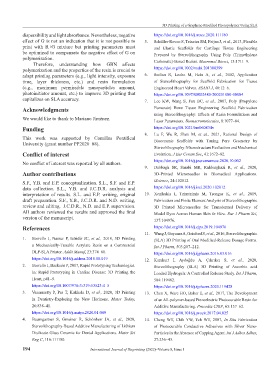Page 208 - IJB-8-1
P. 208
3D Printing of a Graphene-Modified Photopolymer Using SLA
dispersibility and light absorbance. Nevertheless, negative https://doi.org/10.1016/j.msec.2020.111180
effect of G is not an indication that it is not possible to 5. Schüller-Ravoo S, Teixeira SM, Feijen J, et al., 2013, Flexible
print with R+G mixture but printing parameters must and Elastic Scaffolds for Cartilage Tissue Engineering
be optimized to compensate the negative effect of G on Prepared by Stereolithography Using Poly (Trimethylene
polymerization. Carbonate)-Based Resins. Macromol Biosci, 13:1711–9.
Therefore, understanding how GBN affects
polymerization and the properties of the resin is crucial to https://doi.org/10.1002/mabi.201300399
adapt printing parameters (e.g., light intensity, exposure 6. Sodian R, Loebe M, Hein A, et al., 2002, Application
time, layer thickness, etc.) and resin formulation of Stereolithography for Scaffold Fabrication for Tissue
(e.g., maximum permissible nanoparticles amount, Engineered Heart Valves. ASAIO J, 48:12–6.
photoinitiator amount, etc.) to improve 3D printing that https://doi.org/10.1097/00002480-200201000-00004
capitalizes on SLA accuracy. 7. Lee KW, Wang S, Fox BC, et al., 2007, Poly (Propylene
Acknowledgments Fumarate) Bone Tissue Engineering Scaffold Fabrication
using Stereolithography: Effects of Resin Formulations and
We would like to thank to Mariano Jiménez. Laser Parameters. Biomacromolecules, 8:1077–84.
Funding https://doi.org/10.1021/bm060834v
8. Lu F, Wu R, Shen M, et al., 2021, Rational Design of
This work was supported by Comillas Pontifical Bioceramic Scaffolds with Tuning Pore Geometry by
University (grant number PP2020_08).
Stereolithography: Microstructure Evaluation and Mechanical
Conflict of interest Evolution. J Eur Ceram Soc, 41:1672–82.
No conflict of interest was reported by all authors. https://doi.org/10.1016/j.jeurceramsoc.2020.10.002
9. Dabbagh SR, Sarabi MR, Rahbarghazi R, et al., 2020,
Author contributions 3D-Printed Microneedles in Biomedical Applications.
S.F., Y.B. and E.P. conceptualization. S.L., S.F. and E.P. iScience, 24:102012.
data collection. S.L., Y.B. and J.C.D.R. analysis and https://doi.org/10.1016/j.isci.2020.102012
interpretation of results. S.L. and E.P. writing, original 10. Xenikakis I, Tzimtzimis M, Tsongas K, et al., 2019,
draft preparation. S.F., Y.B., J.C.D.R. and N.D. writing, Fabrication and Finite Element Analysis of Stereolithographic
review and editing. J.C.D.R., N.D. and E.P. supervision. 3D Printed Microneedles for Transdermal Delivery of
All authors reviewed the results and approved the final Model Dyes Across Human Skin In Vitro. Eur J Pharm Sci,
version of the manuscript.
137:104976.
References https://doi.org/10.1016/j.ejps.2019.104976
11. Wang J, Goyanes A, Gaisford S, et al., 2016, Stereolithographic
1. Borrello J, Nasser P, Iatridis JC, et al., 2018, 3D Printing (SLA) 3D Printing of Oral Modified-Release Dosage Forms.
a Mechanically-Tunable Acrylate Resin on a Commercial Int J Pharm, 503:207–212.
DLP-SLA Printer. Addit Manuf, 23:374–80. https://doi.org/10.1016/j.ijpharm.2016.03.016
https://doi.org/10.1016/j.addma.2018.08.019 12. Karakurt I, Aydoğdu A, Çıkrıkcı S, et al., 2020,
2. Borrello J, Backeris P, 2017, Rapid Prototyping Technologies. Stereolithography (SLA) 3D Printing of Ascorbic acid
In: Rapid Prototyping in Cardiac Disease: 3D Printing the Loaded Hydrogels: A Controlled Release Study. Int J Pharm,
Heart, p41–9. 584:119482.
https://doi.org/10.1007/978-3-319-53523-4_5 https://doi.org/10.1016/j.ijpharm.2020.119428
3. Vasamsetty P, Pss T, Kukkala D, et al., 2020, 3D Printing 13. Chen X, Ware HO, Baker E, et al., 2017, The Development
in Dentistry-Exploring the New Horizons. Mater Today, of an All-polymer-based Piezoelectric Photocurable Resin for
26:838–41. Additive Manufacturing. Procedia CIRP, 65:157–62.
https://doi.org/10.1016/j.matpr.2020.01.049 https://doi.org/10.1016/j.procir.2017.04.025
4. Baumgartner S, Gmeiner R, Schönherr JA, et al., 2020, 14. Cheng WT, Chih YW, Yeh WT, 2007, In Situ Fabrication
Stereolithography-Based Additive Manufacturing of Lithium of Photocurable Conductive Adhesives with Silver Nano-
Disilicate Glass Ceramic for Dental Applications. Mater Sci Particles in the Absence of Capping Agent. Int J Adhes Adhes,
Eng C, 116:111180. 27:236–43.
194 International Journal of Bioprinting (2022)–Volume 8, Issue 1

